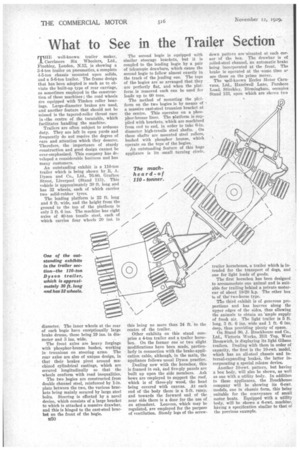What to See in the Trailer Section
Page 188

If you've noticed an error in this article please click here to report it so we can fix it.
MHE well-known trailer maker, Carrimore Six Wheelers, Ltd., Finchley, London, N.12, is showing a 3-4-ton trailer on pneumatics, a complete 4-5-ton chassis mounted upon solids, and a 5-6-ton trailer. The frame design that has been adopted is such as to obviate the built-up type of rear carriage, as sometimes employed in the construction of these machines ; the road wheels are equipped with Timken roller bearings. Large-diameter brakes are used, and another feature that should not be missed is the tapered-roller thrust race in the centre of the turntable, which facilitates handling the machine.
Trailers are often subject to arduous duty. They are left in open yards and frequently do not receive the degree of care and attention which they deserve. Therefore, the importance of sturdy construction and good design cannot be over-emphasized. This company has developed a considerable business and has many customers.
An outstanding exhibit is a 110-ton trailer which is being shown by It. A. Dyson and Co., Ltd., 76-80, Grafton Street, Liverpool (Stand 113). This vehicle is approximately 30 ft. long and has 32 wheels, each of which carries two solid-rubber tyres.
The loading platform is 22 ft. long and 8 ft. wide, and the height from the ground to the top of the platform is only 3 ft. 6 ins. The machine has eight axles of 49-ton tensile steel, each of which carries four wheels 20 in§. in diameter. The inner wheels at the rear of each bogie have exceptionally large brake drums, these being 19 ins. in diameter and 3 ins. wide.
The front axles are heavy forgings with phosphor-bronze bushes, working in trunnions on steering arms. The rear axles are also of unique design, in that their brakes pivot around machined cylindrical castings, which are secured longitudinally so that the wheels conform with road inequalities.
The two bogies are constructed from double channel steel, reinforced by 1-in. plate between the two, the various brackets being mainly secured by large steel bolts. Steering is effected by a novel device, which consists of a large bracket to which is attached a massive drawbar, and this is hinged to the cast-steel bracket on the front of the bogie.
}150 The second bogie is equipped with similar steerage brackets, but it is coupled to the leading bogie by a pair of telescopic drawbars, which cause the second bogie to follow almost exactly in the track of the leading one. The tops of the bogies are so arranged that they are perfectly flat, and when the platform is removed each can be used for loads up to 60 tons.
The method of mounting the platform on the two bogies is by means of a massive cast-steel trunnion bracket at the centre. This operates on a phosphor-bronze liner. The platform is Slipplied with brackets, -which are machined from end to end, in order to take 6-in. diameter, high-tensile steel shafts. On these shafts are mounted steel rollers, bushed with phosphor bronze, which operate on the tops of the bogies.
An outstanding feature of this huge appliance is its small turning circle, this being no more than centre of the trailer. 24 ft. to the Other exhibits on this stand comprise a 4-ton trailer and a trailer horsebox. On the former one or two slight modifications have been made, particularly in connection with the brake-application cable, although, in the main, the appliance follows usual Dyson practice.
Dealing now with the horsebox, this is framed in oak, and five-ply panels are built up upon the side members. Ash bows are employed to support the roof, which is of three-ply wood, the head being covered with canvas. At each end of the body there is a 5-ft. ramp, and towards the forward end of the near side there is a door for the use of an attendant. Louvres, which may be regulated, are employed for the purpose of ventilation. Steady legs of the screw
down pattern are 'situated at each corner. of the box. The drawbar is of rolled-steel channel, an automatic brake being incorporated at the front. The brake is operated at the -same time ar are those on the prime mover.
The -aril-known Eccles Motor Caravans, Ltd., Hazelwell Lane, Pershore Load, Stirchley, Birmingham, occupies Stand 183, upon which are shown two
trailer horseboxes, a trailer which is intended for the transport of dogs, and one for light loads of goods.
The first horsebox has been designed to accommodate one animal and is suitable for trailing behind a private motorcar of about 18.-20 h.p. The other box is of the' two-horse type.
Vie third exhibit is of generous proportions and has louvres along the upper edges of the sides, thus allowing the animals to obtain an 'ample supply of fresh air. The light trailer is 5 ft. long, 3 ft. 6 ins, wide and 1 ft. 6 ins. deep, thus providing plenty of space.
On Stand 90, J. Brockhouse and Co., Ltd., Victoria Works, Hill Top, West Bromwich, is displaying its light Gibson trailers. Dealing with them in order of capacity, the first is the 10-cwt. model,' which has an all-steel chassis and internal-expanding brakes, the latter incorporating a special release device.
Another 10-cwt. pattern, but having a box body, will also be shown, as well as one with a utility body. In addition to these appliances, the Drockhouse company will be showing its 6-ewt. models, one in chassis form, this being suitable for the conveyance of small motor boats. Equipped with a utility body, will be shown a 6-cwt. machine. having a specification similar to that of the previous example.








































































































































































































































































































































